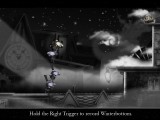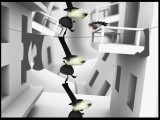Steam Treasures: The Misadventures of P.B. Winterbottom
Published under the 2K Play budget moniker and developed by the aptly named the Odd Gentlemen, The Misadventures of P.B. Winterbottom is a story of the titular gentleman thief getting suckered into a paradox of time, place and the self. His strange-sounding shenanigans are dressed in lavish Victorian-style steampunk and early filmic elements, coated with a glaze of Edward Gorey – rated “E” for “Comic Mischief” by the ESRB – and finally capped by the swinging sounds of a boisterous backing band – sporting harpsichord, bassoon and all – not too unlike Tim Burton’s go-to Oingo Boingo man Danny Elfman’s gothic scores. All this in Adobe Flash! Did I yet mention pie, the strangest of McGuffins? There exists so much pie in the world of P.B., in fact, that it quite possibly takes the cake of having the most pie in a video game ever. Even the primary villain – a massive magical pie that has eluded P.B. W.B. and ultimately led him to his ponderous predicament – counts for this quota! It is fitting, then, that the game has been rendered with plenty of piety (as you could hopefully gather from my description above), going further than most in its reappropriation of its influences, like the silent filmic era, by using as condiments for instance title cards for explicating plot and having pun-filled subtitles for level names.
Did I yet mention pie, the strangest of McGuffins? There exists so much pie in the world of P.B., in fact, that it quite possibly takes the cake of having the most pie in a video game ever. Even the primary villain – a massive magical pie that has eluded P.B. W.B. and ultimately led him to his ponderous predicament – counts for this quota! It is fitting, then, that the game has been rendered with plenty of piety (as you could hopefully gather from my description above), going further than most in its reappropriation of its influences, like the silent filmic era, by using as condiments for instance title cards for explicating plot and having pun-filled subtitles for level names.
As peculiar and confusing as the backdrop sounds, the game establishes its various concepts kindly, one at a time, and lays down a foundation for the core mechanics in a more narrative-oriented, playable introduction at the very beginning of the puzzling adventure.
The key idea of the game, then, is to steal pies with the means of cloning Mr. Winterbottom. Yes, that’s the aforementioned paradox: By pressing down a recording key while navigating P.B. in the back alleys, factories and houses of the murky city, players can generate clones of themselves repeating various tasks, like simply running around, or jumping, or serving as platforms: you can stand on top of their (your?) top hats even when they move! Each level in the game, then, requires a more or less carefully orchestrated set of such clone loops that will ultimately allow the anti-hero to reach each pie. Doesn?t sound too difficult? It isn?t, and yet it is ? often, it is perfectly evident what need be achieved in a particular level, yet implementing a working chain of clone loops can be a different matter entirely.
The carefully-designed looping mechanism that forms the backbone of the game’s play is not only unconventional, but also highly defined and refined: Yes, you can fix your mistakes until you succeed, but actually getting it right takes skill and precision. Yes, you can record clones of yourself, but the amount of clones is often highly limited. Yes, the clones do loop, but interference will also confuse them and they will halt, dumbfounded, in their tracks; Mr. Winterbottom can swing at the clones with his cane, propelling them high into air, but also disappearing afterwards. New functions for the clones, like serving as platforms in the water, arise as you proceed through the game’s five levels. It is perhaps thanks to these strange, even incoherent limitations that all-new, fresh mind-bending scenarios consistently appear as you progress onwards.
It’s not that the game is simply carefully designed, either; its mechanisms are jubilant, its whole existence making fun out of the concepts of time and destiny. In this respect, the game’s treatment of time, though much like Braid‘s, is wholly, utterly different in tone; while the mechanisms of manipulating time and the use of a pre-recorded clone remain shared – and Jonathan Blow in fact served as an advisor on the game – the stylistic similarities end here: Where Braid is whimsical yet brooding, its ironies sharp and biting, P.B. Winterbottom remains joyous, comedic and its ironies fanciful and carefree. Where Braid’s design forces players to adapt to situations on the fly, in Mr. Winterbottom players can rest assured that necessary skills have been drilled well beforehand.
Unlike Blow’s highly singular (to the point of being pedantic) game, Winterbottom is progressive in its use of puzzles, piling on more and more mechanisms on top of the baseline record/loop cloning pattern, often resulting in almost an overload of information: You can clearly see where to start, and how to proceed, but actually doing it is different from seeing it, and seeing it is once again different from thinking it. Controlling all your Winterbottoms also requires precision, and though solutions may be apparent from the get-go, much like an all-new recipe, they require much in the way of repetition on the road to perfection.

 In this way, the game is indeed very intensive on the player as s/he cognitively maps out (or alternatively, trials and errors) and orchestrates each step of the performance in advance ? perchance this is how directors feel, laying out a new shoot? More befuddlement still arises when the pies begin to appear in non-linear order, prompting the need for more segmented solutions still. Many of the more convoluted end-game levels are indeed defined by the performative aspect that lends to the game a curious feeling of play in a fascinating mixture of all the various connotations of the word.
In this way, the game is indeed very intensive on the player as s/he cognitively maps out (or alternatively, trials and errors) and orchestrates each step of the performance in advance ? perchance this is how directors feel, laying out a new shoot? More befuddlement still arises when the pies begin to appear in non-linear order, prompting the need for more segmented solutions still. Many of the more convoluted end-game levels are indeed defined by the performative aspect that lends to the game a curious feeling of play in a fascinating mixture of all the various connotations of the word.
And it is in the looping, pre-recorded nature of the game that lends to multi-layered satisfaction, too: First, the player gets the puzzle and seeks out to realize it. Second, they also have to orchestrate it to meet the possibly very stringent temporal requirements! This often leads to two very distinct “a-has” and epiphanies in the very same level, often further enhanced by the player watching his or her recordings unfold, as if a play or a film, cheering and begging the clones to get through in time. This highly layered construction of seeing, thinking, performing and finally watching makes the game feel far more complex – and rewarding? – than it quite possibly is!
According to the developers, the fact that the clones do loop in the game was actually an attempt to eliminate failure states in the prototyping stage; designer Matt Korba explains that as the game grows progressively more complex, it ?can become extremely punishing. I discovered this early and made Winterbottom’s actions loop so you never lose by missing the timing.?
Eagle-eyed players of the game will also notice that the game sports a copyright for the years 2004-2010! The game’s curiously long gestation period is explained by the games origins as a student thesis project at the University of Southern California. Later, the game was also an entrant to the IGF 2008 Student Competition. Korba talked about the university experience, outlining many of the game’s defining features in one single sentence:
All this said, it does remain curious how a bewildering amount of graphical design has been applied to a game whose unique charms are principally in the realms of gameplay. It’s not that the game’s “macabre” stylings are particularly superfluous; the fact simply remains that the game could have had any kind of skin, really, and still be worthy of a recommendation. It just so happens that the game’s modus operandi deprives the game of a more profound connection between “skin” and “content”, no matter how skilfully the application of irony, for instance, has been ultimately performed. No amount of pie, I’m afraid, will correct this aspect. (Cake, though, apparently functions as a known remedy.)
Additionally, while the PC interface does display some remains of its XBLA background, the game utilizes so few keys that a gamepad is not in the least necessary. In fact, the game plays excellently on the keyboard. Unfortunately, perhaps thanks to its Flash base, the game performs poorly, with rather ghastly load times, and doesn’t run on low-end laptops. Also overlooked are 4:3 resolutions, which sometimes fail to fully display widescreen-designed text strings.
The Steam release of the game comes bundled with 12 achievements, though most of them are either awarded for completing worlds or rewarded for performing well in a series of “bonus shorts” which extend the game’s length quite a bit. All in all, The Misadventures of P.B. Winterbottom is a stirring example of ludicrous design come fascinating reality, bundled in a beautiful package. Don’t forget the game is discounted 90% until the 2nd of January on Steam.




0 Comments
Recommended Comments
There are no comments to display.